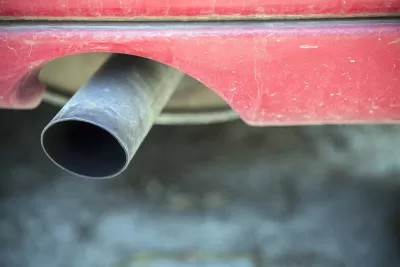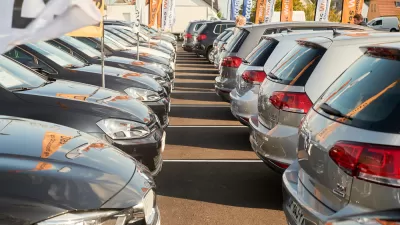Emissions prevented by new tailpipe standards announced by the Biden administration in December 2021 will be measured in the billions.

The news broke that the U.S. Environmental Protection Agency had finalized new greenhouse gas emission standards for passenger car and light trucks on December 20, reversing standards imposed by the previous Trump administration and resetting to emissions standards put into place by the Obama administration.
Planetizen picked up the news at the time, focusing on the new standards (i.e., cars, SUVs, and pickup trucks must release an average of 161 grams of carbon dioxide per mile by 2026) and provided a brief recap of how the emissions standards administrations have seesawed between recent administrations, but another article by Emily Pontecorvo for Grist focuses on the environmental consequences of the new standards. Here, Pontecorvo summarizes the new rule at length:
The agency says the new standards will prevent 3 billion tons of carbon dioxide from entering the atmosphere over the next 30 years and will reduce gasoline consumption by 360 billion gallons. By reducing the amount of fuel burned, the standards will also lower emissions of other pollutants that harm public health, like microscopic particle pollution and nitrous oxides. The EPA expects the standards to generate $190 billion in benefits for Americans by improving public health, saving drivers money at the pump, and lessening the potential impacts of climate change.
Pontecorvo also reports additional details of how the Biden EPA arrived at the new standards and more of the political milieu into which the new standards emerge.
FULL STORY: EPA cuts through the smog with the strongest-ever clean car standards

Maui's Vacation Rental Debate Turns Ugly
Verbal attacks, misinformation campaigns and fistfights plague a high-stakes debate to convert thousands of vacation rentals into long-term housing.

Planetizen Federal Action Tracker
A weekly monitor of how Trump’s orders and actions are impacting planners and planning in America.

San Francisco Suspends Traffic Calming Amidst Record Deaths
Citing “a challenging fiscal landscape,” the city will cease the program on the heels of 42 traffic deaths, including 24 pedestrians.

Defunct Pittsburgh Power Plant to Become Residential Tower
A decommissioned steam heat plant will be redeveloped into almost 100 affordable housing units.

Trump Prompts Restructuring of Transportation Research Board in “Unprecedented Overreach”
The TRB has eliminated more than half of its committees including those focused on climate, equity, and cities.

Amtrak Rolls Out New Orleans to Alabama “Mardi Gras” Train
The new service will operate morning and evening departures between Mobile and New Orleans.
Urban Design for Planners 1: Software Tools
This six-course series explores essential urban design concepts using open source software and equips planners with the tools they need to participate fully in the urban design process.
Planning for Universal Design
Learn the tools for implementing Universal Design in planning regulations.
Heyer Gruel & Associates PA
JM Goldson LLC
Custer County Colorado
City of Camden Redevelopment Agency
City of Astoria
Transportation Research & Education Center (TREC) at Portland State University
Jefferson Parish Government
Camden Redevelopment Agency
City of Claremont





























